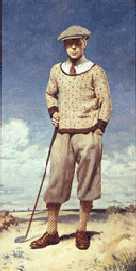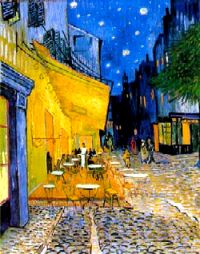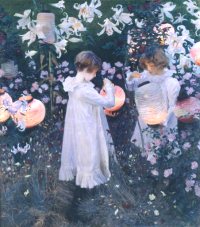Populism and Art |
Populism is a «belief in the rights, wisdom, and virtues of common people». It is a political philosophy which asserts that «the common people are oppressed by an elite class, and that the instruments of the State need to be wrested from this self-serving group and used for the benefit of the people». The first definition comes from the Canadian Food Inspection Agency (and why not!), the second from Wikipedia.

In an age of elitism, James McNeill Whistler wrote «If more than 5 percent of the people like a painting then burn it for it must be bad.»
The trouble for traditional art is of course that it is essentially elitist. Many artists desperately want to be popular but it's just not in their nature. And thus arises the fundamental dilemma, expressed by Belgian philosopher Dieter Lesage: «In the struggle against populism (and any discussion ‘on’ populism believes itself to be part of the struggle ‘against’ populism) it is difficult to not give in to populism oneself. It is an effect that challenges art and politics equally: raising the question what can we do to resist it?»
Why resist it? Why not go with the flow? The urge to be different is embedded in all artists. «I passionately hate the idea of being with it, I think an artist has always to be out of step with his time » Orson Welles (1915 – 1985).
It is an error to conjoin the urge to aesthetic dissent with political or social dissent. Philosophers might call it a category error. It does however provide a source of funds for otherwise barren artistic projects: Populism was the title for a series of exhibitions featuring several artists in Europe in 2005. It had the manifesto
Populism aims at shedding light on the new populist experience by reflecting the shift to new, mass media based politics which embody new ways of aestheticising the political and which go beyond traditional party divisions. A critical departure point for the project is also how mass audiences are increasingly organised around contemporary art and are used for the branding of cities and the forging of new lifestyles. In this way, the Populism project addresses the ambivalences and antagonisms within a populist reality. Populism is a political exhibition because of its involvement in and working through of populist discourses and practices. Through this, it is our hope to participate in the public debate about the fleeting, yet urgently present phenomenon of populism. (more here). Spot the deliberate error: the conjunction of artistic and political metaphors. A good gambit to grab Euro-grants from befuddled Brussels bureaucrats.
Populism is a modern invention. Its rise in the West has accompanied the fall in respect for traditional undisputed authority be it Church, State or Profession. Men who kick a ball around a park are feted and lavishly rewarded; men who cure cancer are not.

Sir William Orpen (1878-1931) was the best known British artist of his time. The elite queued outside his opulent Chelsea home to have their portraits painted and yet he attained total obscurity almost as soon as he was cold in his grave. «Twenty years after I die, nobody will remember me» - and his sumptuous portraits sold in the nineteen fifties for a fraction of their original price, while he was dismissed for his abundance of Rolls Royces and absence of intellectual curiosity.
Edward Prince of Wales (1894 - 1972), later Edward VIII, became Captain of the Royal & Ancient Golf Club in 1922.
This little homilly shows that we have to be careful when referring to the elite. In the art world the elite are quite a different set from the elite of society. Each subgroup of humanity has its own little elite. History, in art or anything else, is rewritten by today's elite applying today's conventions. Tomorrow, history will be rewritten again according to the prevailing moral condition.
And what of the I-don't-know-anything-about-Art-but-I-know-what-I-like school? We have to be careful not to dismiss this in the same way as we have in the past dismissed the cultures of, say, primitive human societies, or indeed other species. It is all too easy to unconsciously apply our own values when evaluating others and in so doing to overlook their cultural depth. Equally, it's easy to get sucked into relativism and end up with no meaningful analysis at all. The fact that the man in the street can't articulate his reasons for liking or disliking something is not a reason to assume he hasn't got any or that they aren't valid. Quite the reverse - these are difficult areas of discourse and it's likely due to a variety of influences from peer pressure to individual cultural history to genetics. Who amongst us can completely and honestly analyse and write down his own feelings on anything?
The most successful Schools of Art have been those who could tap into the popular subconscious. Artists should not sneer at popularity. Pseudo intellectual analysis may appeal to the chattering classes but history is the ultimate judge of quality. And history is not written by the vocal majority. If your art outlives you by twenty years, then you've done pretty well. |
| |
| by The Impressionist on Mon, 30 Oct 2006, 09:23 |
|
|
|
Finding and Acquiring Fine Art on the Internet |
Although it's relatively new, the internet has changed the way we discover and acquire art. More now than ever before we have the ability to find, view and acquire fine art from the comfort of our own home.
Viewing, selecting and buying art online is very much like visiting bricks-and-mortar Art Galleries. Of course on your browser you see only an image of a work rather than the work itself and this makes it harder to visualise. However, many websites offer tools to alleviate this problem, as we describe later.
The power of the internet to provide information is both a blessing and a curse. There is so much choice, but that can make finding a suitable work like finding a needle in a haystack. However, if you use the internet in a methodical way, you can find something that fits your requirements perfectly.
Here are some tips for finding and choosing a work of art online ...
- Specify: it can help to have an idea of what you're looking for even if just in 'broad brush' terms: contemporary, abstract, decorative, or figurative? What color scheme are you trying to match? What size is your hanging space? Try to write down a list of criteria you are trying to match - writing it down helps to concentrate the mind, and you can change it at any time.
- Explore: You have more choice than ever before. If you have a favourite style or school of art, search engines like Google, MSN or Yahoo will find you thousands of examples. Google image search or Froogle - which shows images - can be helpful. Many art sites have links to other sites that you can follow. Some artists have grouped themselves into 'collectives' in which you can visit their own websites and view what they have to offer. All this, of course, takes time - but if you are serious about owning original art, it's worth it.
- Research: Learn about the type of art that you like. Most people like decorative art, so-called because it is generally used to decorate living and working space rather than to be provocative. It's not wrong to dislike certain schools of art or art movements. Don't be put off by snobbishness - art appreciation is almost entirely subjective, in spite of what some 'experts' may claim! Don't be afaid to ask questions. Most quality online art galleries have experienced art consultants who are pleased to answer any of your questions. We have a contact form that you can use to put questions about our artworks. Please don't hesitate to ask.
- Experiment: Some websites offer sophisticated tools that can give you a realistic visualisation of their offerings. For example, on our site here you can view works in several different settings: contemporary, art deco, traditional, office, kids, etc., varying the wall colors, and with a range of frames and mattes/mounts. Your chosen work is scaled to the room setting to give you the sense of how large it is. On the details page, you can enlarge, i.e. zoom, the work to see it in more detail.
- Make the Right Choice: Share your favourite works with people you trust – email their links to friends or colleagues and get their opinions.
- Be Safe: When you are sure you have found the right piece, enquire about the site. Most credible websites provide you with detailed information about themselves. Check their whois registration, for example at Tucows. Check that the site offers verified and secure online purchasing. Read what their customers and the press have to say about them. Check if the piece will come with authentication that you are happy with. Find out if they have a returns policy that is reasonable. When you have satisfied yourself that the company is genuine, make your purchase and enjoy your acquisition with confidence.
|
| |
| by The Impressionist on Sun, 24 Sep 2006, 11:27 |
|
|
|
Investing In Art |
«It is only an auctioneer who can equally and impartially admire all schools of art» - Oscar Wilde.
Wilde's aphorism reminds us that although we usually acquire art to brighten up our lives, there is an industry out there for which creativity is a commodity to be traded like coffee or oil. Whatever our feelings on the matter, most of us would be proud to have spotted the potential for financial gain in a Turner or a Picasso. If only my grandfather had been friends with Vincent Van Gogh ...
If you're one of the Super-Rich

At first sight, the gains can be impressive, for example between 1976 and 2002, the top 2 percent of the art market outperformed various stock indices in the US:
Art Top 2% 11.3%
S&P 500 8.4%
Dow Jones 8.5%
(Sources: Art Market Research and Bloomberg)
So $1m invested in art over the period could have become $16m whereas the same $1m invested in the stock market would have become a paltry $8m. This is fine for the super-rich who can afford to buy into the top 2 percent of the art market but what about the other 99.999...0f us?
If you're Really Quite Rich
If you are somewhat risk-averse or feel you don't have enough expertise to manage your own portfolio, you could consider an art fund - a sort of unit trust of art rather than shares. In the UK an investment vehicle - the Fine Art Fund - was set up in 2004 and has shown some impressive gains. However, this fund is typically for wealthy investors with a minimum stake well into the six figure region. Cold comfort for the prospective small investor.
The Rest of Us
Art for investment's sake (Ars Gratia Pecuniae) is a very risky business. If you are happy with risk then you really need to understand what you're getting into. The maxim that you should never invest more than you can afford to lose is at least as true here as for any other type of speculation.
Many factors affect the price of art, these include:
- the artist and his/her reputation;
- art world fads and fashions;
- the quality of the work compared to others by the same artist;
- the subject matter of the work;
- the medium in which the work is executed
- the physical size of the work;
One strategy might be to look for a good self publicist. Many artists and their agents try to get a 'buzz' going in the art world, perhaps by being provocative or outrageous. It's a trick that's widely used in other arts-related industries and, astonishingly, it still seems to work. Salvador Dali was a great self publicist, with his waxed moustache and pretty female companions dressed in complementary colours he exuded the air of a Bohemian. His obscurantist exclamations only made him seem more mysterious and interesting.
Be warned however that reputations can be broken overnight. A recent example is that of Mark Kostabi whose work was collected by Sylvester Stallone amongst others and whose prices were in the $10K plus region. An unfortunate non-PC remark made to Vanity Fair back in 1989 (about gay museum curators who controlled the art world dying from AIDS) led to his ostracism by some of those curators (the ones who survived) and a collapse in price. You may take the view that these things will pass and Kostabi's work is worth investing in, or you may decide to look elsewhere.
Be sure that you know in which direction the market is moving; what is becoming fashionable; what is dropping back. For example, according to Forbes Index, French Impressionist paintings fell badly towards the end of the nineties, but recovered strongly in the first couple of years of this century. It's easy to get stuck with a piece for a long time while fashion rotates beneath it. (Personally, I wouldn't have a problem being stuck with a Renoir).
Paradoxically, the physical characteristics of a painting seem to carry less weight. Oils have been traditionally considered to be more permanent than watercolours and so are generally more highly valued. Oils and acrylics can be applied impasto (i.e. thickly!) and so are less likely to be affected by poor display conditions like bright light. In general larger works are more difficult to execute and so command higher prices. An overly large size restricts the market for the piece but for the right artist that could include the wealthier end: institutional and corporate buyers, and rich private individuals.
People tend to buy into their own culture when they can. As economies grow and people get a higher disposable income, they begin to patronise local art producers. Art experts are watching China and India whose quota of wealthy art patrons is growing along with their economic wealth.
Art Market Research

The successful art investor, like Wilde's auctioneer, must divorce his or her personal likes and dislikes from his business sense. Market research and 'insider' knowledge are critical.
Buying art is easy. Selling art is hard. The investor must know what to sell, who to sell to, and when to sell.
It can take a while to turn over works of art so the investor must budget for increased insurance premiums and perhaps, additional security measures. Comprehensive research is essential before investing.
Some research resources:
- The Forbes Index compares various types of art in relation to the S&P 500 index.
- The Mei/Moses index is perhaps more up to date and authoritative but requires registration.
- Website Artnet offers market trends analyses, a price database and a valuation service.
Caveat Emptor
The foregoing is only a rough guide to the sort of considerations art investors must make and live with. It does not constitute advice or recommendations. All investors are responsible for their own decisions in that it is the investor and no one else who benefits or loses.
My personal opinion? Art is for pleasure, enlightenment, the satisfaction of owning something completely unique. If you like a work, buy it and enjoy it. Don't pay over the odds and don't lose sleep over it. Who knows? - you might just pick a winner. |
| |
| by The Impressionist on Sun, 24 Sep 2006, 11:20 |
|
|
|
|
|